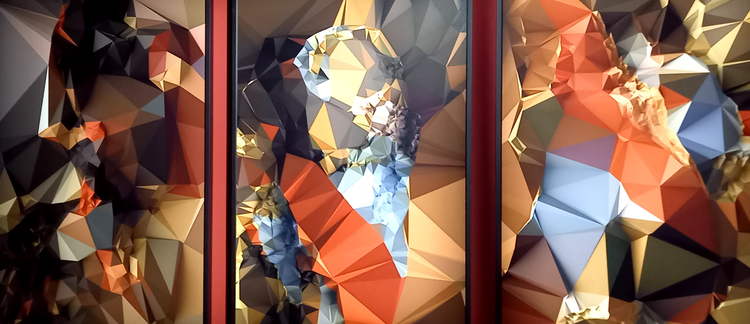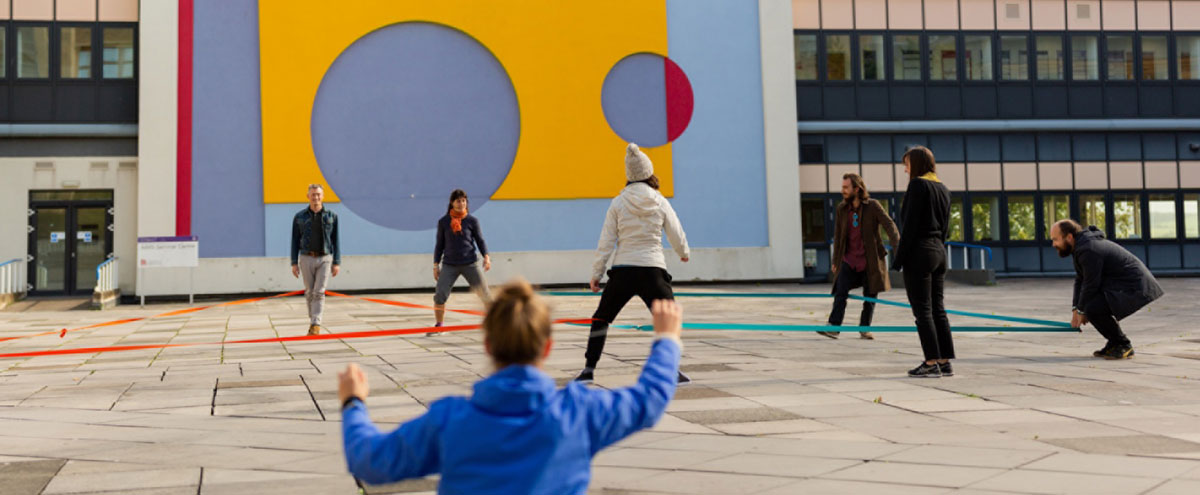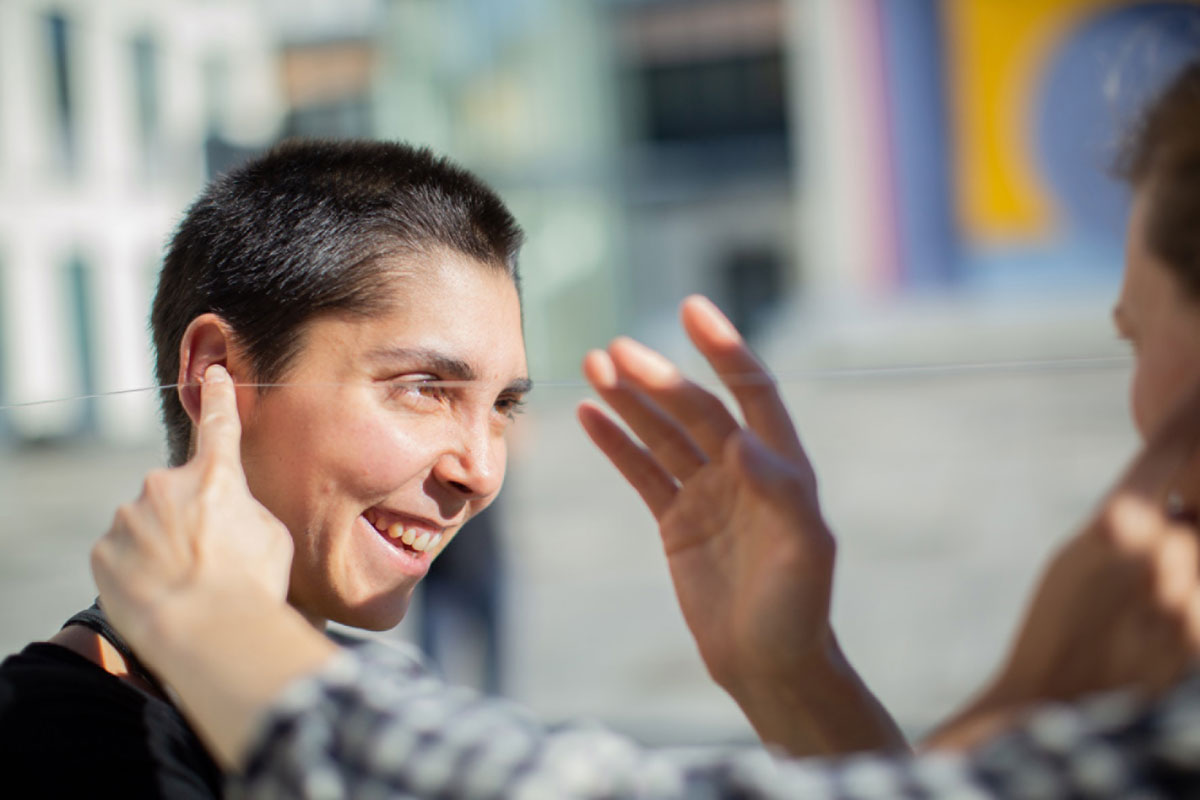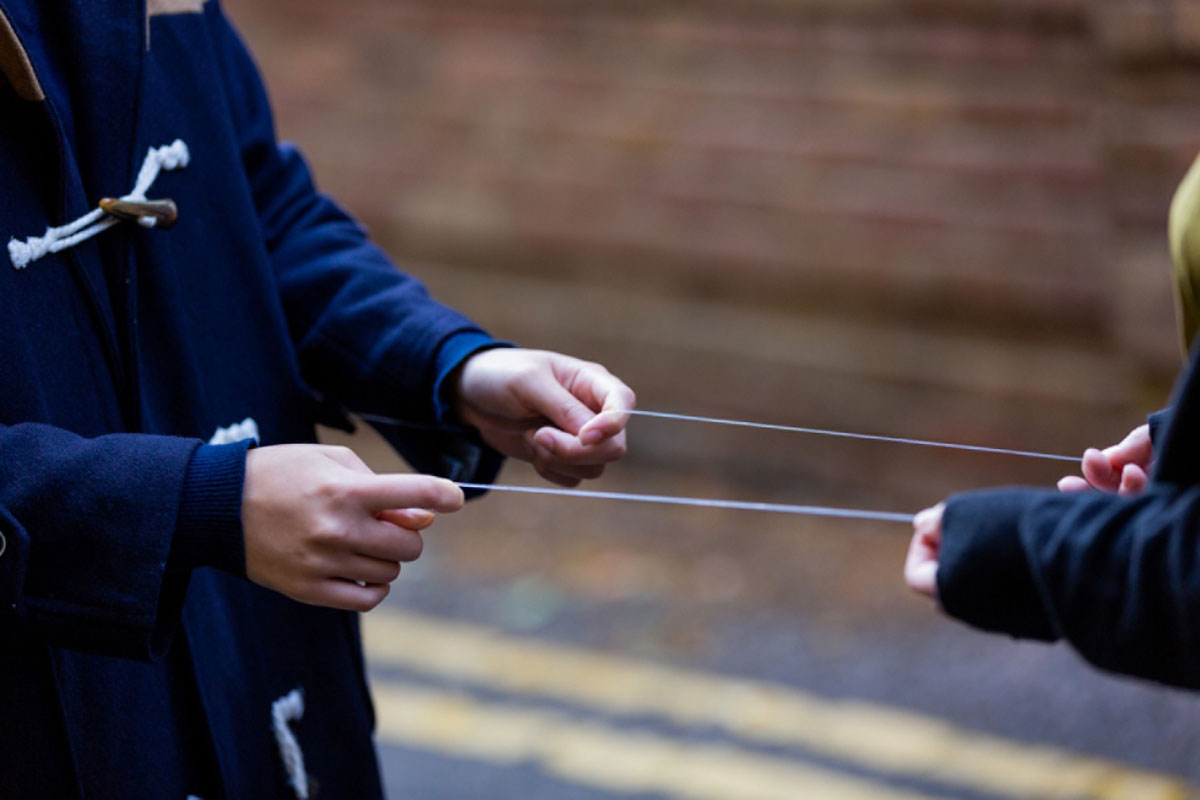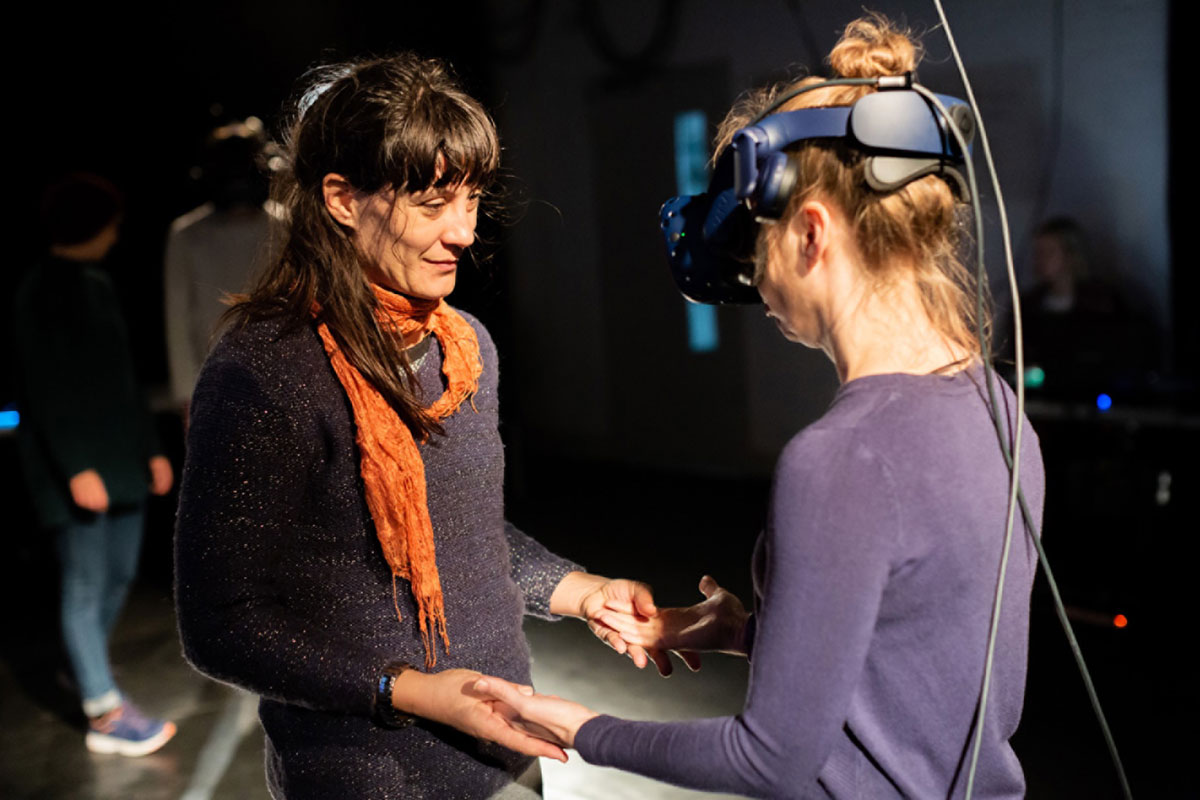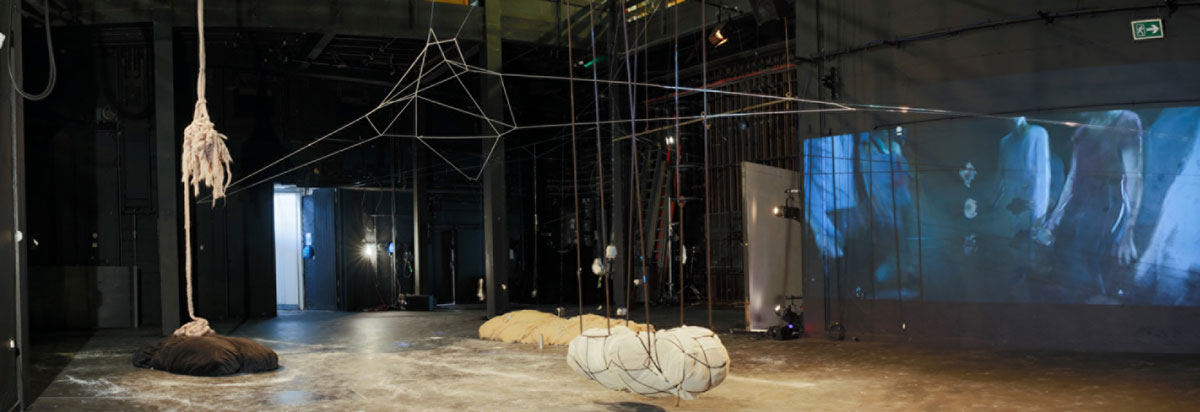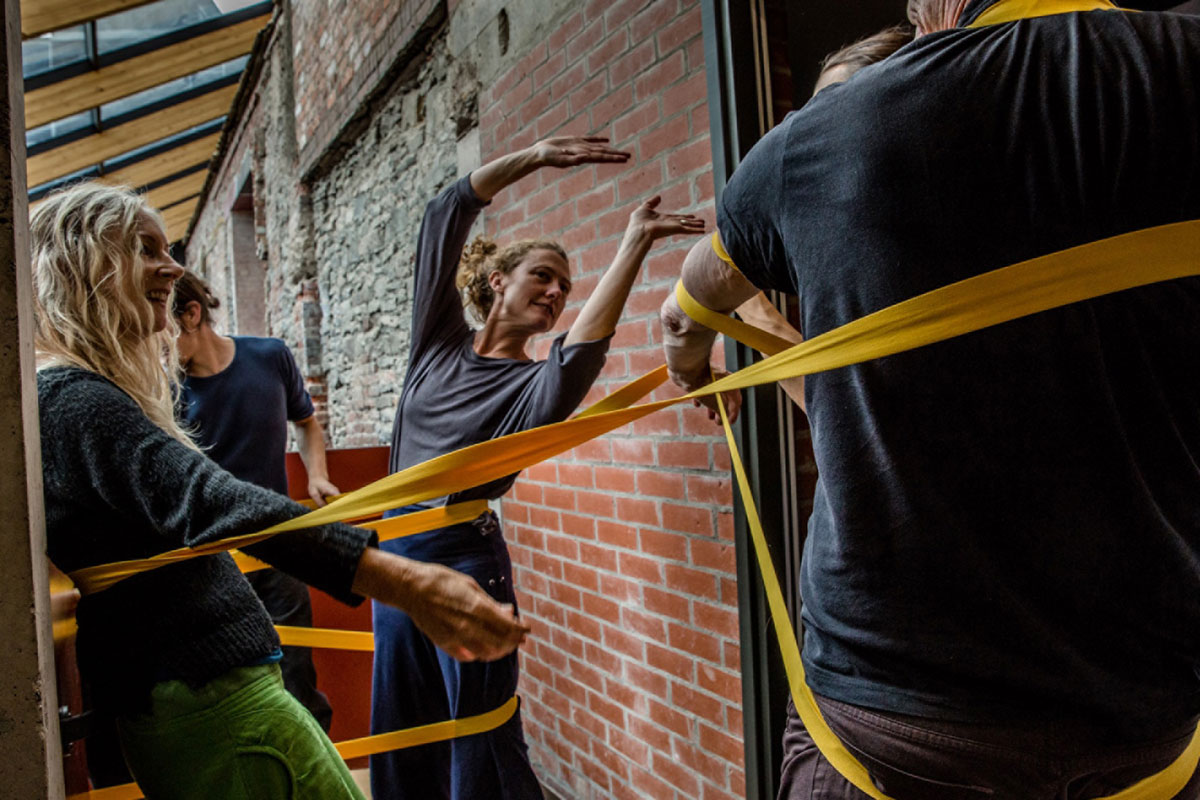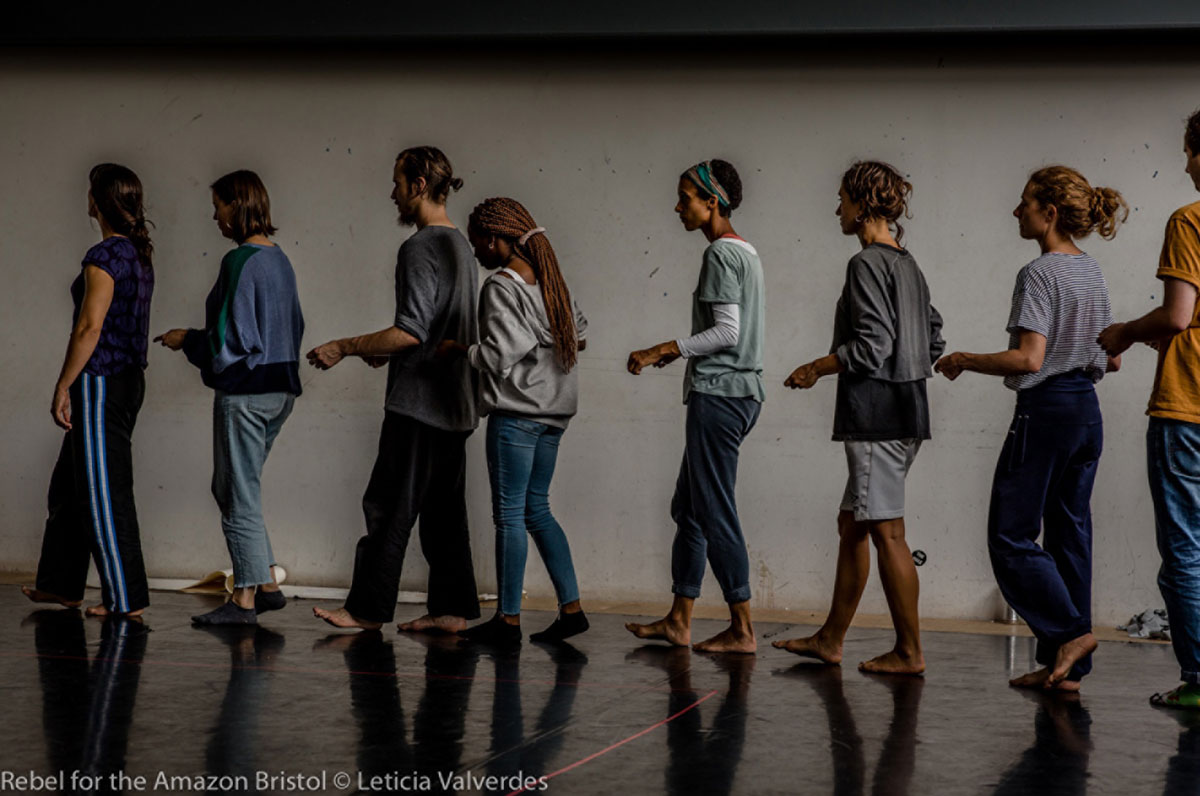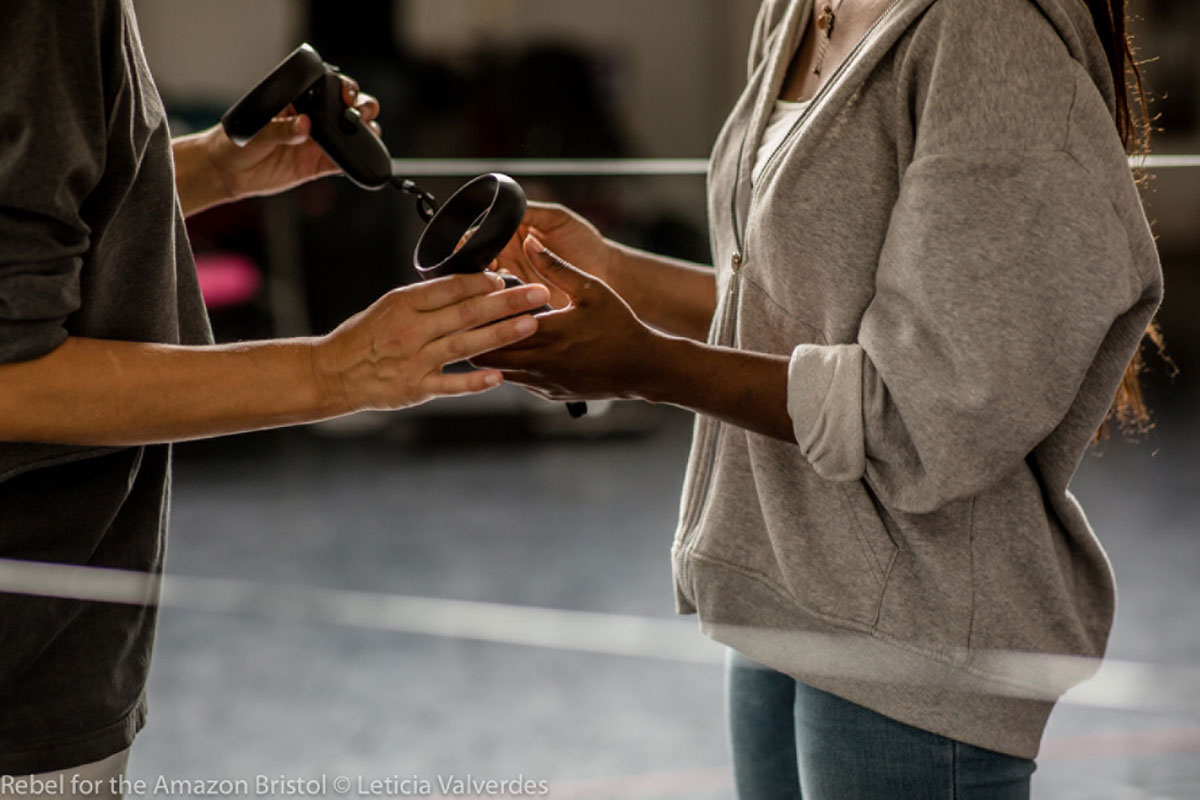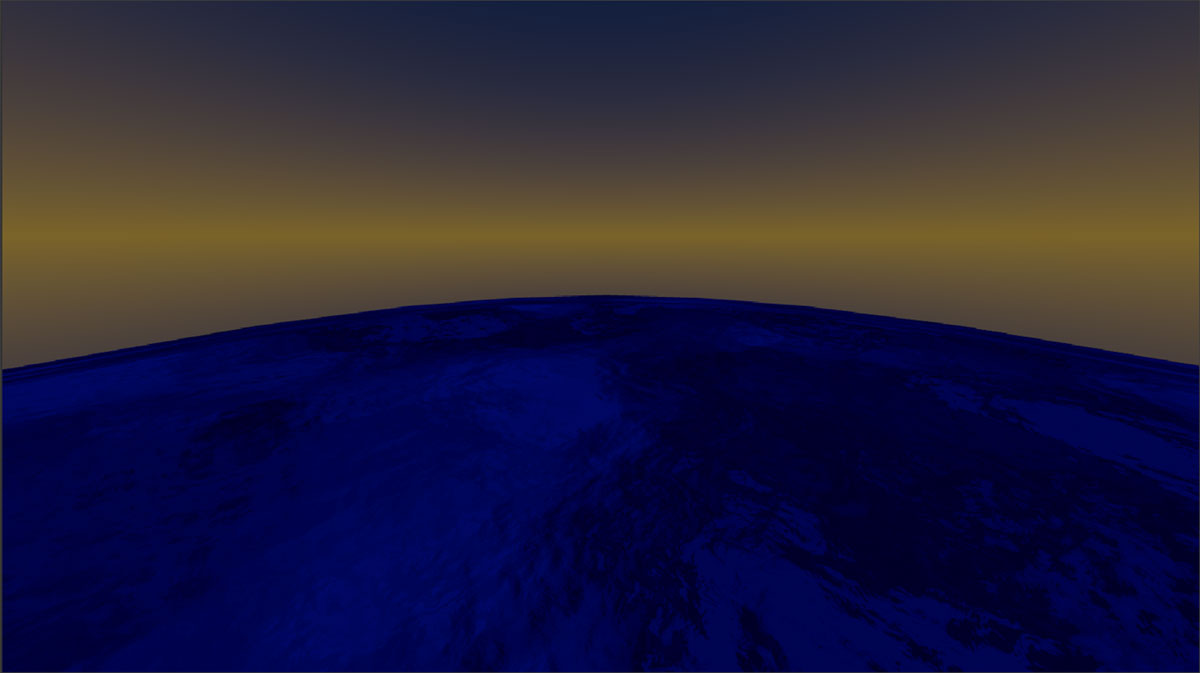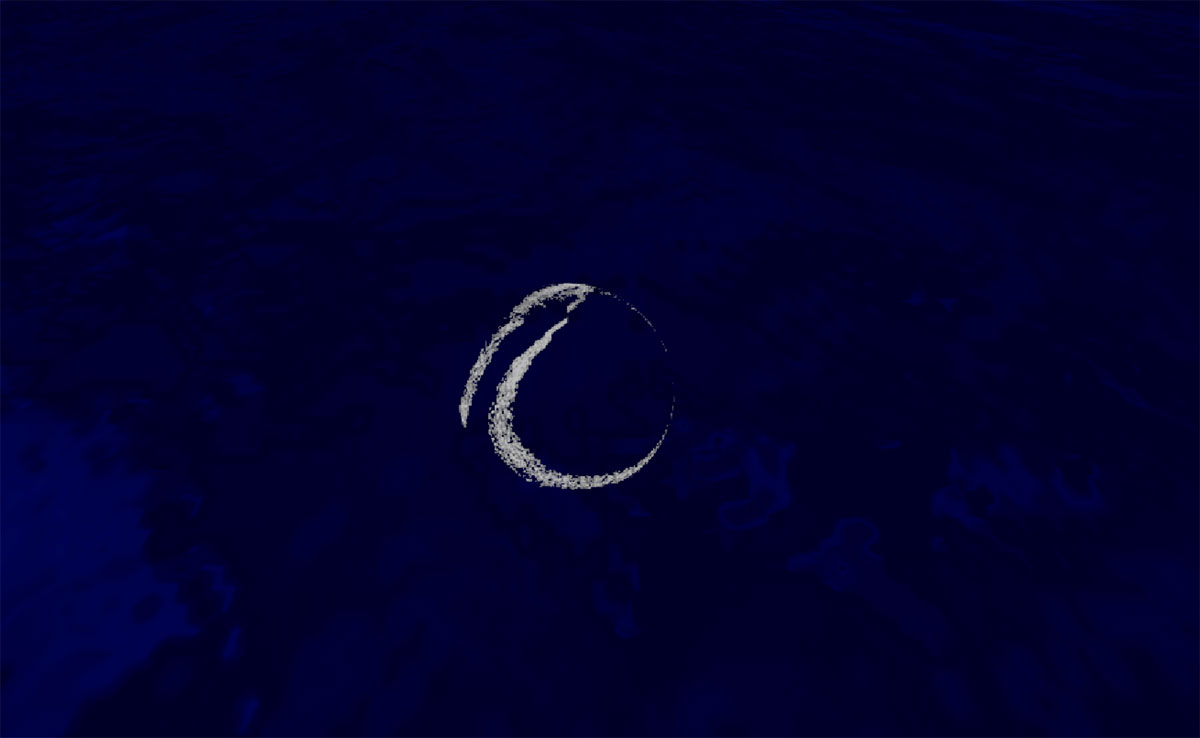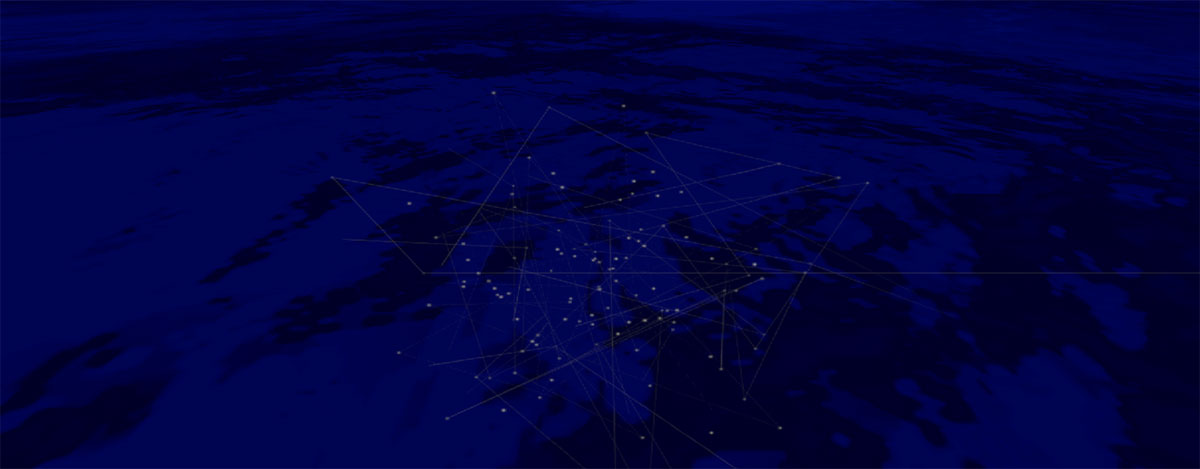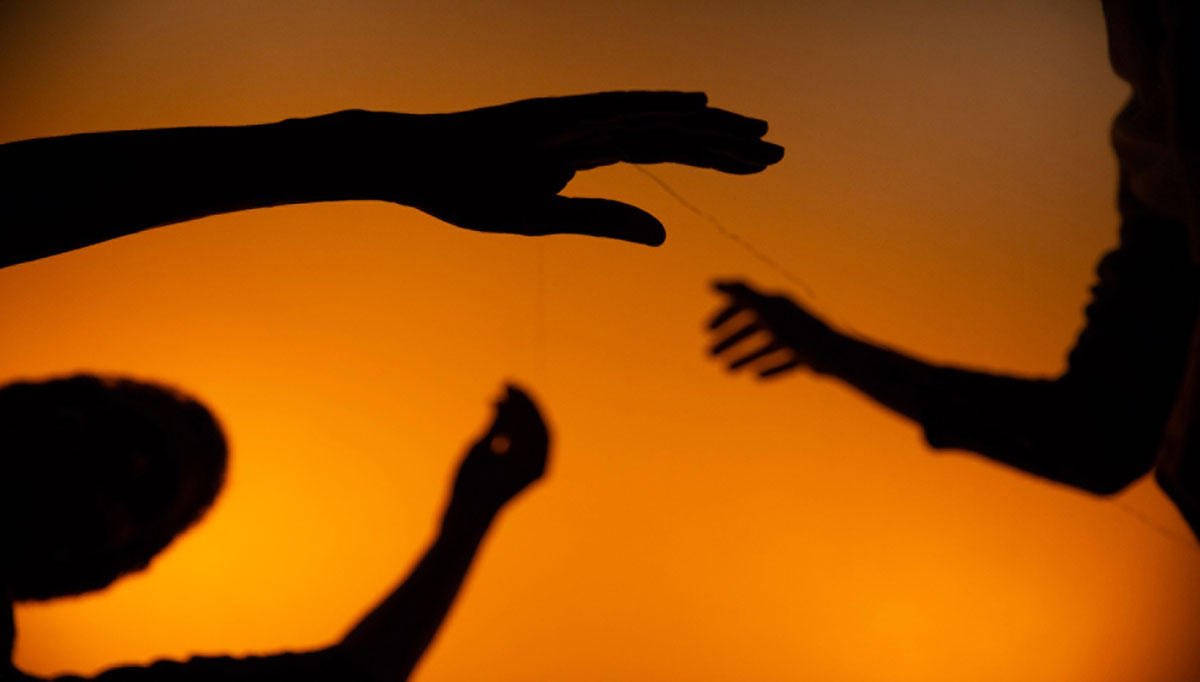Introduction
This article draws from a dance-somatic standpoint to explore the complexities of body-technology relations across the virtuality and corporeality of bodies and environments using multi-person Virtual Reality (VR) technology. Immersion into a virtual environment (VE) using VR technology can lead to a sense of presence, of being there in that VE. This illusion of presence in a VE relies on the sensory system being led by vision.
Human attention embeds in modes of perception and in processes of embodied construction through and as technologies. ‘[W]e have moved into an era of representation of the self through diverse virtual bodies, thereby expanding ourselves into many selves’ (Broadhurst and Machon 2012: 77). In our participation in and with technology, ‘we aid the gradual dissolution of the boundaries between the real and the virtual’ (Broadhurst and Machon 2012: 77). In very recent times, the COVID-19 pandemic has led to a rapid increase in the use of (visual) technologies (such as Zoom). This has resulted in the loss of a sensibility and the physicality of a felt engagement between bodies sharing a space – a scenario foundational to dance training, practice and performance. Whilst some bodies are back together occupying the same spaces, more than ever relations between bodies and their environments are mediated by and through technology. The summoning of a felt presence of the ‘other’ - with or without techno-mediation - is crucial to the critical ‘recuperation of the incarnate, sensorial dimension of experience’ (Abram 1997: 65) and - in the reciprocity, the ‘recuperation of the living landscape in which we are corporeally embedded’ (Abram 1997: 65). New York Times journalist Gia Kourlos writes, ‘[i]f this pandemic is teaching us anything, it is that we need to return to our bodies’ (Kourlos 2020), a sentiment this article critically engages with. This article maps a ‘return to the body’ which includes, challenges and makes use of technology. The performance practices written about in this article offer a model for exposing and understanding the ways in which VR disturbs, disrupts and even severs the sensorial body and points to ways in which these disturbances can be explored and understood.
Dancing bodies move attending to a field of sensation which is felt and tactile. Dancers undertake somatic and sensory practices to re-tune their senses as synaesthetic (Machon 2009): The notion that the senses operate as a flexible and adaptable system, not dominated by one sense i.e. vision. These dance-based practices de-centre vision so to foreground and activate the non-visual, somatic and interoceptive senses. From the sensory standpoint of a dancer trained in this way, entering into a VE brings into play the immediate effect of a perceptual tension or gap between the visual, virtual environment and the physical, felt environment (Thomas and Glowacki 2018). Technologists and artists engaging with VR typically find ways to cover over these gaps in order to create a reality that is fluidly and synchronously experienced by the participant. This article introduces and discusses two participatory performance projects Figuring (2018) and Soma (2020) which combine VR technology with dance-somatic practices to challenge this approach. By exposing and sustaining the sensation of the perception gap calls into question normative bodily-sensorial arrangements with technology and opens up expanded sensory terrain in human-techno relationships. These performance works were authored my myself in collaboration with a number of talented scientists, creative technologists, artists and dancers (please refer to the acknowledgements for their names and roles in each of the projects).
Drawing on the two performance projects, this article discusses how a dance-somatic approach can productively intervene in the VR technologists’ or artists’ ambition to make continuous the flow of reality through the visual world presented by the VE. In this article I first situate these two pieces within current practice and literature, in discussing the ways in which the body and the senses are considered in the development of VR experiences and in dance and somatic practices. Second, I outline and discuss five key themes drawn from the experiences of the Figuring participants, detailing where their responses to the work informed the development of Soma. The conclusion offers learning and insight into the sensorial nature of human encounters with VR which challenge normative notions of both body and technology. It discusses the ways in which Figuring and Soma, as participatory performance research methods, are novel ways for exploring sensory bias and agency; the practices of care that dance and dancers can offer to working with immersive technologies such as VR; and offer methodological reflections on how qualitative thematic analysis processes intervene in intuitive thinking and artistic practice.
VR immersion, perception, performance, and dancing bodies
Immersion in a VE, using VR technology, can lead to a sense of presence, of ‘being there’ in that environment (Slater 2009). On inhabiting a virtual body within a VE, ‘[w]e recognise our own habituation there’ (Slater and Usoh 1994) and ‘recognise the habituation of others through the representation of their own bodies’ (Slater and Usoh 1994: 18). The visual information from the physical world is not available to the senses and moves into the background. Whilst the body is still physically present in the physical space, the sense of being there temporality goes away in favour of the visual VE. The senses rally to fill in the gaps, presenting the VE as the body’s perceived ‘reality’, and overwriting the (non-visual) physical sensations that come in from the physical space. In a VR experience, there can often be moments in which the physical reality or absence of the physicality of the virtual phenomena arises in the participants attention. Moments in which there becomes a perceptual gap between seeing (the visual virtual environment) and feeling (the physical environment) (Thomas and Glowacki 2018): reaching out to touch a virtual entity which does not exist physically or touching something in the physical space, which is not represented visually in the VE, or more subtle sensorial sensations. In 1966, Michel Foucault wrote of the blind spot between the eyes, a gap in which there is no visual information (Foucault 1966). Yet, he writes, ‘there is really only one opening – since what I see facing me is only one continuous landscape, without partition or gap’ (Jones 2006: 1). In reality, the gap is occluded, and the experience of reality fluid and singular. Experiences with VR technology are often designed to similarly cover over the physical environment and replace it with a visual VE, drawing on the visually-dominant mode of sensing most humans adhere to. The physical world disappears from the experience and, it is, as with the blind spot between the eyes, hidden from the flow of perceived reality.
ZU-UK Artistic Director Persis-Jadé Maravala writes about her first VR experience:
The roller coaster was going down. I don’t like things like that. But I became completely obsessed with the thought that my brain would believe something even when I knew it wasn’t true. I kept trying to meditate my physical reaction. All the physical sensations and reactions were already in play so I was trying to override my brain system by saying, ‘It’s VR. You’re not really on a roller coaster’. I couldn’t do it. My body felt like it was truly free falling. My stomach turned and my head started spinning. That was the fascination. The body will believe something and the conscious mind can’t. Our involuntary systems are stronger. I found that little patch of inconsistency really interesting, the space. (Dunne and ZU-UK 2018: 216–217)
Interactive VR performance combining VR and binaural technologies Good Night Sleep Tight (Gerry’s Kitchen 2017), created by Maravala and collaborators, uses this ‘little patch of inconsistency’ (Dunne and ZU-UK 2018) in ‘constructing a false reality which is hard to override’ (Dunne and ZU-UK 2018: 219). VR experiences such as the one described here bring in other sensory inputs which are aligned with the visual virtual information to trick the brain into believing in a reality that creates ‘physical urges or sides of themselves that they can’t control or can’t resist’ (Dunne and ZU-UK 2018: 219). Maravala writes, ‘[t]he brain needs two or three stimuli to believe this is reality. You see your body, you feel the touch and hear the sounds…’ (Dunne and ZU-UK 2018: 219).
In contrast to this approach, Figuring and Soma are specifically designed to not operate in alliance with a technologically constructed reality; but to bump up against it, priming and embedding attention in somatic and relational sensibilities, in bodies and environments which collide with the pull of a visual virtual world. Dancing bodies move attending to a field of sensation which is felt and tactile, the senses operating synaesthetically with vision. This dancerly mode of sensing is at odds with the way that VR technology employs vision to lead the way, as the driver of the senses. In VR, the sensory information which is critical to dancers is supressed or reduced in the designed perceptual experience. Drawing from this dance-based mode of sensing, the two performances discussed in this article offer a participatory experience with VR which disrupts the normative use of the senses it affords. These performances invite participants to experience the felt as a parallel mode for being in the world alongside the seen and to undertake a shared exploration of their own sensorial and embodied attention between the two ‘realities’. In Figuring and Soma, the participants move attentionally between the corporeality and virtuality of their experience. The body mediates both, extending, not limiting the capacity to sense, move and act within and across these realms.
Caroline Jones, professor of art history at MIT, argues that ‘commodity culture will continue to put its faith in the instrumentality of vision’ (Jones 2006: 21) and that it is key to find ways to ‘relinquish the visual ordination of intellectual knowledge’ (Jones 2006: 21). Renowned psychologist J.J. Gibson, whose ideas have been used as building blocks for perceptual understanding in the development of technologies such as VR, writes that ‘[o]ne sees the environment not just with the eyes but with the eyes in the head on the shoulders of a body that gets about’ (Gibson 1986: 222). Whilst Gibson brought the body and the movement of the body into the act of seeing, his notions still orient perception around vision – the eyes as the centre point from which all bodily sensation and experience is initiated. This ocularcentric perspective, ‘[t]he domination of vision in our knowing and thinking about the world’ (Belova 2006: 93), has led to ‘objectivist and disembodied understandings of reality’ (Belova 2006: 93), which disempowers and devalues non-visual sensory information in the formation of the ways in which the ‘realities’ of bodies and environments and their interrelations are perceived; perceptions that are ‘built upon knowledge provided by optical technologies’ (Ihde 1990). Technologies such as VR reinforce a (Gibsonian) visually led perceptual system and thus the habituated neural and embodied pathways between vision and the rest of the body. Consequently, the body’s capacity for prioritising or re-synthesising other sensorial information in relationship to, not dominated by, vision, is reduced.
This research intervenes in and disrupts normative human modes of engagement with technologies that serve to further this visual ordination. Embodied knowledge in dance offers pathways to sensing the body, other bodies and the environment which background the visual and bring to the fore a felt and relational presence of the human and non-human world. Phenomenologist David Abram writes about processes of sensory transformation, through which ‘[c]ertain phenomenon that have habitually commanded our focus begin to lose their distinctive fascination and to slip toward the background, whilst hitherto unnoticed or overlooked presences begin to stand forth from the periphery and to engage our awareness’ (Abram 1997: 63). These synaesthetic processes through which ‘the perceived world begins to shift and transform’ (Abram 1997: 63), are akin to those acquired by dancers through somatic and improvisation training. ‘Now more than ever we need to think of the body’ (Jones 2006: 1) and to ‘question the stability and natural order’ (Jones 2006: 21) or ‘arrangement’ (Jones 2006: 21) of the senses. The participants of Figuring and Soma are invited to attend to the sensorial aspects of their encounters with VR, tooled in processes of shifting their visual ‘centre of gravity’ toward a felt sensing, opening their awareness ‘to the process of being aware of this shifting’ (Machon 2013: 201).
Draw Me Close, written and directed by Jordan Tannahill (2020), uses VR in a narrated one-to-one experience, physically enacted between a participant wearing a VR headset and a performer-actor whose movements are tracked using a motion capture suit and seen in the VE by the participant. The experience describes a mother-and-son relationship, drawing from the makers’ own experience, and uses touch/physical contact in acts of intimacy through the narrative between the performer and the participant. Wilson writes about his experience of intimacy in the work and the way in which this is mediated by the technology, ‘even if I felt uncomfortable or awkward during moments of the performance, I did not have to look the performer directly in the eye’ (Wilson 2020: 8). In his writing about the experience, Wilson refers to:
…moments when my attention was taken out of the narrative world and I became aware of the physical and technical limitations of the piece. Very occasionally, I noticed the wires attached to the HMD as they pulled me slightly after a sudden head movement. There were moments when the motion capture animation did not completely line up… or when I could not find the window frame as my visual perception in the simulation did not accurately correspond to the physical location of the window. (Wilson 2020: 8)
Wilson considers the perspectives of those who ‘see these technological limitations as VR’s failings – barriers to immersion that, once the technology improve, will lead to a greater feeling of presence in the simulation’ (Wilson 2020: 8). Yet he himself experienced these moments differently, ‘far from being a failing of this performance to immerse me, the tactile stimuli and breaks in presence created a kind of tension between intimacy and distance that was emotionally charged but allowed me to retain my critical faculties’ (Wilson 2020: 8). Aspects of the technological ‘material’ which were not designed to be revealed were exposed and created moments of rupture in Wilson’s experience. These ruptures were, for Wilson, a pleasurable ‘oscillation between intimacy and distance’ (Wilson 2020: 8), allowing him to enter into the experience materially. His body was active and present, not absent, in his participation. Figuring and Soma journey participants through somatic-sensory tuning processes which lead into an encounter with VR, designed to offer similar moments of rupture, in exposing the ways in which this tuning is somewhat at odds with the visually dominant mode of sensing the technology requires.
Figuring and Soma
This section introduces and describes the two performances at the centre of this article - Figuring and Soma. I start by outlining the three-phase model which operates as the structure for both pieces, following which I describe each piece in more detail – their overlaps and differences.
Figuring and Soma are hour-long experiences which are grounded in a moving and sensory play with the materiality of strings using a multi-person, interactive VR technology framework. Four participants are accompanied by four dancer-guides through a three-phased experience - with equal emphasis placed on each phase: i) pre-entering the VE, ii) being in the VE, and iii) the after-space of the VE. The dancers are ‘guides who initiate’ (Machon 2016: 40) the participants as ‘interactors into the world[s]’ (Machon 2016: 40) tooling the participants in a somatic sensibility, ‘[a]ctivating the imagination and proprioceptive senses in such ways enables interactors to intuit their way through the event’ (Machon 2016: 40). Underpinning both pieces is a participatory journey which invites a re-tuning of sensory awareness towards the non-visual, inviting the participants to experience their bodies and the physical environment around them in non-visual ways, as felt and sounded (prior to entering the visual VE). This sensory tuning takes place as a physical string-play in the first phase of the journey, which tools the participants in a movement-based mode of engagement, play and interaction and toward a physical, felt connection with each other through the strings. Non-visual sensorial participation is further emphasised in an eyes-closed walk which moves the participants between physical and virtual environments using the strings. In the second phase of the journey which takes place in VR – in a VE which contains an interactive virtual string, and which invites a further string-play in this virtual domain - there is a continued emphasis on the relationship between the participants and the dancers, inviting a shifting of attention between and across the layering of the physical and virtual environments (with the participants visually present within the VE and the dancers physically present in the physical space). Once the headset is taken off, the third phase journeys participants into a post-VR ‘residue’ environment to support the continuation of the sensory shifts that have occurred, a sensory space which activates the imagination.
Figuring was developed with a team of collaborators (please refer to the acknowledgements) and delivered for thirty participants at the University of Bristol in September 2018. The Figuring journey began with each of the four dancers pairing with one of the four participants, setting up a one-to-one connection with them through the physical string-play, string sounding and eyes-closed walk (Figures 1, 2 and 3). Throughout the piece, the dancers offered a scripted sequence of invitations to their participants. HTC Vive Pro VR technology was used, which consisted of four VR headsets which are tethered to large laptops at one side of the space, with two hand-held controllers for each person. The Figuring VE that was used, was originally designed as a system that scientists can use to interact with molecular-dynamic processes based on computational data running in real-time in the three-dimensional environment (O’Connor et al. 2018). The virtual string was housed within an aesthetically simple environment – a transparent white outlined cube within a dark featureless environment – and shifted through different visual states, sonified through speakers in the room. The participants’ bodies were visually represented, first as box bodies - box-like designs which corresponded to the position of the HMDs and controllers – and then as cloud bodies – blurry body representations which moved through different colours and latent effects (the effect of a delay between the physical and the virtual body representation). With the participants interacting in the VE, the dancers mostly operating as caretakers of the physical space - making sure the participants did not bump into anything or trip over the wires that were crossing through the space, as well as performing specific movements which aimed to disrupt the visual flow of the VE for their participants (such as wafting and sounding the air around the participants bodies and tapping the edges and corners of the floor - activity that was unseen by the participants) (Figure 4). On exiting their VR headsets, the participants were led by an imaginary string into the final residue environment which was designed with elements of projection, seating, and sound (Figure 5).
Soma was developed following on from the Figuring prototype performances and through the analysis of participant feedback. The creative process for Soma took place through additional research and development time in the studio with the dancers, with new technical collaborators and using a different VR technological framework – the untethered Oculus Quest (please refer to the acknowledgements). A series of focus groups, including visually impaired participants, were brought in to test the newly designed experience, informing the development of the piece. The Soma journey used the starting string-play to invite participation which led toward a group play, an improvised ensemble (rather than the focus being on one-to-one exchanges as took place in Figuring) (Figures 6 and 7). Once their eyes were opened into the VE, the participants were guided by the dancers to explore the virtual environment through physical and verbal exchanges. These were not set invitations (as they were in Figuring), the dancers worked with a devised toolbox of practices in response to the shared exchanges between themselves and the participants and between physical and virtual environments or realities (Figure 8). The Soma VE was designed to offer aspects of a physical, ‘real-world’ environment, with a ground and sky which was seperated by a horizon (Figure 9). In the opening of the VR section of Soma, from the horizon of this environment emerged an interactive, virtual string which shifted in aesthetic, movement/physics, and sonic qualities (Figure 10). There were two body states in Soma – initially the participants hands were represented as hand balls (Figure 11) providing the location of their own and others’ hands in the VE which supported their orientation in the virtual space and their interaction with the virtual string. The hand balls were taken away after some time so that participants needed to rely more on their proprioceptive sensations rather than the visuality of their virtual hands to locate their hands and move the string. Towards the end of the Soma VR journey, a more abstract body state emerged from the location of the controllers/hands as small points of light which gradually form as lines creating web-like constellations – Pauletta (Figure 12). Before their VR headsets were taken off, the participants closed their eyes, and a very light thread was placed into their hands. They opened their eyes into darkness and there was a very gradual fade up of diffuse yellow light projected from overhead – simulating a sunrise. The threads they moved between them gradually became visible, like silver spiderwebs floating between their bodies. In this final space, the dancers shared and invited a sharing of memories of the experience as the threads were passed and played with. Five small speaker units were situated on the floor which each contained a Soma string sound and were moved by the dancers and participants in this shifting space (Figure 13).
Creative methodologies
In this section I outline the materials collected on the participants’ experiences of Figuring and discuss the analytical and creative process undertaken to develop Soma.
Research participants and materials
The thirty Figuring participants were invited through team connections and their wider networks, consisting of technologists, scientists, dancers, artists, academics. Some participants came with previous VR experience and others had none; some came with previous movement-dance experience and others had none. Qualitative feedback was gathered in two ways: facilitated group discussions with the participants to capture immediate reflections after the experience, and one-to-one interviews which took place between one and three months after the event. Both sets of data were audio recorded and transcribed. The interview questions included a series of open questions which centred on the participants’ physical and sensorial engagement with the work. Throughout the creative processes for both Figuring and Soma, extensive documentation was gathered including video, photography, audio and written/drawn research materials.
Rigorous ethics procedures were followed, approved by the University of Bristol ethics committee. Ethics protocols dealt with bringing people together (collaborators, dancers and participants) in immersive settings, ensuring that safety was a prime concern, and taking into consideration the very specific factors which come with working with VR technology - its participatory conventions and the current ethical concerns in the field (explored, for example, in the work of Madary and Metzinger, and Cortese and Zeller). All participation was voluntary, and participants were informed that they could withdraw at any time and without needing to give a reason. Alongside a consent form, an information sheet was available which detailed the research activity. As the primary researcher, I was available to respond to any questions the participants had on reading and signing these forms. Participants were also able to select, via an additional media consent form, different levels of permissions for the (audio, video and photographic) documentation, in which the use of their data and right to remain anonymous was made explicit.
Analytical and creative process
The transcribed data from the Figuring participant one-to-one interviews and prompted discussions were analysed drawing on the thematic analysis (TA) approach outlined by Braun and Clarke (Braun and Clarke 2006), with support from Dr Tom Mitchell (University of the West of England) and Dr Oussama Metatla (University of Bristol). This approach is a well-used qualitative analytic method within psychology employed to identify, analyse and report on themes within data. The analysis for Figuring entailed a detailed process of coding all of the participants comments and grouping these together as ‘bulding blocks for themes (larger) patterns of meaning, underpinned by a central organising concept; a shared core idea’ (Clarke and Braun 2015: 2). In undertaking this process, I found that I had already intuited many of the themes before they had emerged as patterns in the data – through my own lived experiences of the workshops and performances, the subsequent discussions, and interviews (as co-present body, witness, facilitator, and interviewer), and through my reflective thinking and writing on the events. As the process of coding and pattern analysis continued, I felt that the TA method had started to take me away from the creative practice of the work and my own body, disconnecting me from the individual experiences of the participants and each of their moving sensing bodies. The one-to-one interviews I undertook with the Figuring participants were rich, intimate, and personal exchanges about the memories and imaginings of their embodied experiences of the work. As a dance practitioner and maker, the focus and process of the TA was unsatisfactory to me as it did not go deeply enough into each individual’s felt sense of the experience i had designed. I reverted to taking a critical ethnographic approach as a grounding lens from which to write, and to think through the thematics that had emerged from the initial TA coding process alongside my intuited notions. This enabled me to let the participants’ words inform the practice and to pull out what felt intuitively important and relevant to the research questions which centred on the investigation, using performance-research methods, into tuning and exposing the modes of sensing between dance practices and VR. As I brought my body and sensory standpoint to the fore in unpacking, moving, and writing on the participants’ words, I recognised my own perspective, biases, and limitations in the framing of their experiences (Maddison).
Findings & discussion: Themes from Figuring participant testimonies and the development of Soma
The themes outlined in this section centre on the sensorial and bodily engagement of the Figuring participants through the three-part journey and are grouped according to each of the three phases (before-VR, during VR, and after-VR), drawing also on the participant experiences of the transitional moments or thresholds between each phase. The fifth and final theme details the participants’ experiences of the practices of care intrinsic to the crafting and delivery of the work. Where each theme has informed the development of Soma is outlined in each section.
Through the performative experiences of Figuring and an analytical focus on the bodily and sensorial, many of the participants encountered the VR technology, their own bodies and sensorial attention in new and different ways. Using dance-somatic practices to intervene in and disrupt the normative mode of sensing the technology affords enables an unpacking of modes of sensing, embodiment and perception that can offer insight and learning broader conversations – across HCI and social science domains – into body-technology relationships and issues and concerns around agency, data, and ethical practice as well as novel methodological processes.
1. Tuning practices: Before-VR
This theme pertains to the pre-VR experiences of the Figuring participants. The sensory tuning of the string-play offered sensory pathways to non-visual elements of the physical relationships between the bodies of dancers and participants through the string and with the string itself. In the eyes-closed walk, the participants tuned into the sensory information from the physical environment around them and the touch and movement of the string. Touch, temperature and sound, light on the backs of their eyelids and other interoceptive, internal sensations came into the fore of their experience. There was an ‘awareness of stillness and movement and breathing’ (Participant 2018: 8), somatic sensations, ‘subtle understandings about how you feel about your body’ (Participant 2018–19: 2). This sensory tuning was designed as a precursor to participants entering into the VE, to access or make available their connection toward the physical space and to each other non-visually, felt relations which would continue alongside the visual domain of the technology. ‘It required my body to participate, my attention and different senses’ (Participant 2018–19: 4), ‘[I was] incredibly present in a way that is quite unusual’ (Participant 2018–19: 4). The tuning process drew the participants into a mode of participation away from the ‘everyday’ and its distractions, ‘It’s rare that we’re that invested in exactly what we are doing for that length of time ever, really, these days’ (Participant 2018–19: 4).
Using the strings, the participants explore ‘other domains of communication and expression’ (Participant 2018–19: 5) away from everyday social modes of engagement with ‘the encouragement without any words to get involved’ (Participant 2018–19: 35), a ‘silent communication’ (Participant 2018–19: 5). The dancers invited the exploration of a wide spectrum of movement, from small micro-manoeuvres and gestures to large, sweeping collective and collaborative motion: ‘[we] stood, walked, wandered, picked things up, people kind of walked at each other and then veered off or… and we held onto things, felt the tension in it, maybe made it move together or separately’ (Participant 2018–19: 28). ‘I became the centre of the sort of maypole structure, that kind of allowed us all to kind of climb in, wrapped around with the thick elastic’ (Participant 2018–19: 35).
I think what stuck with me is that running around with an elastic band, and with the other person holding the other end of the elastic… joining in and taking part in my experience of it and allowing me to experience that. (Participant 2018–19: 7)
This tuning activity enabled the participants to gather a physical and tangible sense of their connection to one another through the strings, through space. ‘Transferred through the tension of the elastic, you feel a human body’ (Participant 2018–19: 5). The elastic strings had ‘thing-power’ (Bennett 2010: 2), ‘when it’s been pulled and pushed and tugged, you are actually still feeling the physicality of somebody else through the tension of the elastic and so there’s that communication there through movement and tension’ (Participant 2018–19: 5). Building connection between the participants and the dancers in the string-play supported the sense of trust required in the dancers for participants to close their eyes in the walk. In ‘gradually encouraging us to play in that space’ (Participant 2018–19: 52), there was ‘the kind of lead in that you one hundred per cent needed to get people to expose themselves comfortably’ (Participant 2018–19: 52). In the moment of inviting the participants to close their eyes, ‘I was wholly in it. I was totally trusting’ (Participant 2018–19: 52). In the moment of inviting the participants to close their eyes, ‘I was wholly in it. I was totally trusting’ (Participant 2018–19: 56). The bodies of the participants were contained within the loop of string as they walked, an assembled collective body able to subtly sense one another through the movement of the string, ‘we were holding onto these threads between us, and that was our new kind of parameter’ (Participant 2018–19: 56).
To summarise, the participant responses to this first phase of the performative journey evidence the importance of the sensory tuning process that was undertaken by them. Processes through which there was a tooling of a movement-based mode of engagement and of communication, a tuning into a felt connection between bodies, and a building up of trust between the participants and the dancers. These became tools to ‘load’ a fuller participation and led into an engagement with VR with increased participatory agency. Opening up the participants to a realm of sensing – beyond the visual – prior to entering into the VE, these dancerly practices of moving within and with the materiality of the strings were key in predicating and enabling an encounter with the technology which foregrounded a bodily, sensorial participation.
2. Layered perception in VR
This second theme unpacks the Figuring participant experiences from within the VE, entering into this space from a non-visual sensory standpoint (having undertaken the string-play and eyes-closed walk as sensory tuning in the first phase). Opening the eyes into the VE from a period of time in which participants had been in darkness necessitated a sensory readjustment. “By heightening those senses often deemed as secondary” (Machon, 2016; 43), on returning to ‘seeing’ in the VE, “one is encouraged to look and look again” (Machon, 2016; 43).
It made kind of entering the virtual world less of an abrupt transition and more of a gradual metamorphosis… it was obviously very different to real-world visual information, but because you’d been slightly deprived of it for a while you were a bit more alive to it. It’s a sort of sensual pleasure. (Participant, 2018–19; 17)
The transference from the eyes-closed walk to the VE was like ‘going from one piece of sensory deprivation to another’ (Participant 2018–19: 2). Opening the eyes from a long phase of darkness into the VR was ‘a really arresting experience to be suddenly sort of awoken but in a different reality, which was very powerful’ (Participant 2018–19: 1).
In the VR section, the dancers remained part of the physical space, challenging and disrupting the sensorial attention of the participants whilst they were in the VE, offering crossings between physical and virtual bodies and worlds. For some of the participants there was a resistance to the invitations made by the dancers who disrupted the visual flow, or pull of information being received by the VE. ‘[You were] forced to put most of your attention into the real, the physical world’ (Participant 2018–19: 20). ‘I was trying to stay mostly in the virtual space …it was like trying to focus, and then you’re being sort of forced to divert or split your attention’ (Participant 2018–19: 20). For other participants there was a very real sense of the physical world and the bodies in that space, which were unseen. ‘I remember the people around me, and I remember the space, and the gaps… the virtual experience wasn’t really what stuck with me’ (Participant 2018–19: 56), it was the sense of ‘these other bodies that were present with me’ (Participant 2018–19: 50).
I have a very physical recollection of what it is like, to be guided and touched by people that you can’t see. That was a really striking component of that piece. I am relatively familiar now with seeing other people in VR, and generally that means avoiding walking there – so to be doing something with them collaboratively was so generous and interesting, but it was the bodies unseen that has stayed with me most, all of those things about the physical space, I still don’t really have a reference for, has struck me as a really extraordinary way of feeling. Inevitably, with that kind of thing, every touch is incredibly heightened when I don’t have a visual reference, or I can’t check it, in terms of the audio or the visual, as I am already engaged in this other space. So, to have those two realities playing in real-time, how that felt and how much potency and potential that feels like it has for the form, which is so focused often on what is the visual [and] what is the sort of empathy being generated by this picture of a thing that I am looking at. [The] attention to the body and acknowledgement of those two spaces co-existing, I thought, was really quite profound. (Participant 2018–19: 3)
To briefly unpack what is being reflected on by the participants in this section, the pre-tuning process of the journey, combined with the physical presence and actions of the dancers in the VR section, led to experiences and sensations of two realties occurring simultaneously, exposing a peceived gap between seeing and feeling. Dancer Nancy Stark-Smith says that ‘[b]eing in a gap is like being in a fall before you touch bottom. You’re suspended – in time as well as space’ (Stark Smith 2003: 247). These moments are, as Stark-Smith describes it, ‘one of the precious spots offered by improvisation’ (Stark Smith, 2003: 246). Dance scholar, Ann Cooper-Albright writes about Stark-Smith’s notion of the gap as ‘a space in which to change our habitual responses’ (Cooper Albright 2003: 259). ‘Moments that once were easily and automatically filled have become uneasily and consciously unfilled. By leaving them unfilled, I’m not only breaking a “momentum of being,” a pattern of behaviour, but I’m bringing attention and charge to a moment that would have passed without remark’ (Cooper Albright 2003: 258). The gap is a ‘moment of possibility’ (Cooper Albright 2003: 258), it is ‘a suspension of reference points in which new experiences become possible’ (Cooper Albright 2003: 258). The performative model of Figuring enabled perceptual gaps to occur. In these moments the participants were invited to explore and share their experiences, and the differences between their experiences with one another and with the dancers.
3. The Residue: After-VR
This theme describes the participants’ experiences of the Figuring ‘residue’ environment - the after-space of the VE. It details also how these responses fed into a complete re-development of this VR after-space for Soma.
Participants enjoyed the residue environment as ‘a buffer, a kind of transitional space in which I eased out of playful improvisation and material and embodied ways of engaging with people and objects into conversation and reflection and the social’ (Participant 2018–19: 50), a ‘kind of decompression zone’ (Participant 2018–19: 46). However, for a number of the participants, the visuality of the space had caused them to lose a sense of the felt connection with one another they had built up through the journey, ‘it’s like uncovering everything, you can see everything, and you could see the others, and you can see the other people’s reactions’ (Participant 2018–19: 66). Seeing one another and the physical space made the participants feel ‘more self-conscious’ (Participant 2018–19: 37). ‘I felt less free because I can see everyone’s boundaries now’ (Participant, 2018–19; 41), we were ‘suddenly a bit removed from each other because we could see each other’ (Participant 2018–19: 41). ‘When I saw faces, that was a problem for me. I reimposed a lot of that identity politics straight back onto that space. It seemed to sort of, in some ways, close things down a little bit’ (Participant 2018–19: 49).
For one of the participants, a visually impaired (VI) dancer, Figuring was her first VR experience. This participant is, in her usual sighted experience of the physical, everyday world around her, unable to perceive any depth. In her perception, the three-dimensional details of spaces and objects are reduced, flat and blurry with no defined edges. Stepping into the VR environment in Figuring, this participant was struck by the visual clarity of the VE and the virtual bodies and strings within it, seeing it as a three-dimensional world, ‘I have never seen anything in that amount of depth’ (Participant 2018–19: 9). This experience ‘really opened up the possibilities in my body to move in different ways’ (Participant 2018–19: 9), giving her a physical sensation of her own body as three-dimensional, ‘a felt experience in [her] body from something visually’ (Participant 2019: 12). On exiting the VE, this participant described the residue environment as ‘flat’, that the world had ‘become flat again’ (Participant 2018–19: 11). The sense of depth that she had experienced in the VE had been lost. In response to the unhelpful visuality of the Figuring residue experienced by many of the participants and by the visually impaired dancer, the after-space of VR for Soma was completely re-designed. The Soma environment used light and sound in minimal but agential ways to support a continued sensing which did not revert back to normative, visual territory.
For one of the participants, a visually impaired (VI) dancer, Figuring was her first VR experience. This participant is, in her usual sighted experience of the physical, everyday world around her, unable to perceive any depth. In her perception, the three-dimensional details of spaces and objects are reduced, flat and blurry with no defined edges. Stepping into the VR environment in Figuring, this participant was struck by the visual clarity of the VE and the virtual bodies and strings within it, seeing it as a three-dimensional world, ‘I have never seen anything in that amount of depth’ (Participant 2018–19: 9). This experience ‘really opened up the possibilities in my body to move in different ways’ (Participant 2018–19: 9), giving her a physical sensation of her own body as three-dimensional, ‘a felt experience in [her] body from something visually’ (Participant 2019: 12). On exiting the VE, this participant described the residue environment as ‘flat’, that the world had ‘become flat again’ (Participant 2018–19: 11). The sense of depth that she had experienced in the VE had been lost. In response to the unhelpful visuality of the Figuring residue experienced by many of the participants and by the visually impaired dancer, the after-space of VR for Soma was completely re-designed. The Soma environment used light and sound in minimal but agential ways to support a continued sensing which did not revert back to normative, visual territory.
Performance-making practices activate and expand the imaginations of audiences, and artists play in this realm of the imaginable. Machon writes, ‘[s]ynaesthetic imagination has the ability to induce changes in somatic processes and disrupt the boundary between the real and the imaginary’ (Machon 2013: 204). Creating performance generates a world of potential happenings and situations, characters, bodies, movements, and relationships and, in doing so, opens audiences to new ways of feeling, sensing, and thinking. The Figuring participant reflections on their post-VR experiences in the residue space highlighted the need for this transitional phase. As a recalibration of the senses and to one another and the space around them. The participant experiences of exiting VR and experiencing this after-space also affirmed the ways in which VR technology has a lasting influence beyond its use, offering opportunities for recalling and remembering the sensorial and embodied sensations it had produced. The designed space of the residue environment was experienced by Figuring participants as an unwanted return to the world of visual boundaries and identities, and this learning was taken into the re-design and development of this VR after-space for Soma. Crafting this space for Soma became a queering or feminist manoeuvre for the imagination, an embodied unwrapping of the potential of things, a realisation of the many possibilities that are available in any one moment, a pivoting of futures.
4. Dancerly Practices of Care in VR Encounters
Being in a (multi-person) VE, for some, can enable a sense of being ‘freed up’ (Participant 2018–19: 49), a ‘levelling experience in lots of ways’ (Participant 2018–19: 52) which ‘stripped away any hierarchy’ (Participant 2018–19: 52). In Figuring and Soma, participants are invited to enter into an intimate connection with self and other in sensing their own bodies and the bodies and environments around them. This was an intimacy activated through the enabling effects of the VR technology and through the care of the dancers drawn from their practices. Dance practices are constituted in a ‘deepening of interpersonal exchanges’ (Hamera 2007: 18), intimate exchanges between bodies and environments, as templates for conventions for other ways of being, different to the everyday, common conventions of daily lives, and through which ‘real, desiring, emotional subjects come together across multiple dimensions of difference’ (Hamera 2007: 18).
The entire time, given the complexity and possibility of it, there was no doubt from me at any stage that we were held and looked after, and the risks were understood and being borne by the team. It’s that sort of confidence that the participants can have in the work that was present throughout. (Participant 2018–19: 4)
In Figuring and Soma, there are sections of the journey in which there are differences in the perceptual experience of the dancers and participants: the participants have their eyes closed, whilst the dancers’ eyes remain open; the participants enter the VE, whilst the dancers remain in the physical environment. In these moments, rather than assuming that the one who is sighted leads the other, there can be a non-hierarchical sharing of perception, across the sensory territories of seeing and feeling, with one not dominating the other. This practice of assembling and sharing perception can be an expansion of sensing beyond what is directly available to the body, by accessing the environment through the body and the senses of another. ‘The whole process very much raised my awareness of sorts of touch, I wasn’t touching people, I was, like, being touched and I was connected through the strings’ (Participant 2018–19: 36).
The Synaesthetic Assemblage score (SA) was developed as the grounding practice for Soma taking this notion of care into a relational movement practice. SA began in its development as a duet practice, one dancer with eyes open moving in improvised exchange with another dancer with eyes closed. They move with a sense of one assembled form, the perceptual and embodied sensibilities of one dancer extending to encompass the other dancer, and vice versa. Moving with a partner using physical touch and weight-sharing as a communicable system for the dance form of contact improvisation operates with this sense of shared perception, ‘we move with our partner and as our partner, we are as response-able and ‘in the zone’, as are they. We both go further because of the other’ (Little 2014: 257) and ‘our zone expands because of theirs. We respond as a larger self-sensing, a communion of being. Rather than narrowing the field of care, we expand it, giving further’ (Little 2014).
Our most response-able relationality is one of communion. When we track what our partner knows, we read his or her ‘edges’, where the tones of their comfort become blind or uncertain. We are responsible for being within this zone, which is the zone of their ‘well-being’. They will be open and vitally engaged within this zone. (Little 2014)
During the eyes-closed walk, some of the participants ‘felt quite vulnerable and my body felt quite exposed’ (Participant 2018–19: 40), and it was the presence of the dancers, the ‘gentleness of …someone taking care for you’ (Participant 2018–19: 65) that enabled them to feel ‘safe’ (Participant 2018–19: 6). For some participants, the experience was quite freeing, ‘it actually amazed me how much I enjoyed that sensation of giving up control of navigating a space and experiencing it completely differently’ (Participant 2018–19: 16). There was the sense that ‘trusting with your eyes closed into a quite disorientating virtual space was a really heightened sensation and trying to find comfort within that and have that quite clearly stewarded by the people that were leading us’ (Participant 2018–19: 2).
One of the Soma dancers, Laila Diallo reflects on the negotiations she experienced in this ‘task around empathy and sensing’ (Diallo, 2020), ‘of being with them [the participant] while also giving them space to be alone in the experience’ (Diallo, 2020), finding the practice of it to be ‘a balance between care and allowing some discomfort, some dissonance to allow for perhaps new/different consciousness, sense of being in/of an environment’ (Diallo, 2020). This dance-based ethics of care, a ‘kind of care to place someone in their body and to ground them but also challenge them’ (Participant 2018–19: 2) was a practice that was developed in response to enabling and guiding an embodied and sensorial participation in VR which was not just about leading and following but sharing different experiences of perceived ‘realities’. Care is an attentional capacity which incorporates a mutual response-ability (Barad 2012). A body that consciously extends becomes aware of itself as ‘already opened up to the other from the “inside” as well as the “outside”’ (Barad 2012: 217). It is through this opening and extension that the body finds itself ‘more intimately in touch with the infinite alterity that lives in, around and through us’ (Barad 2012: 217). Sensing the body in its engagement with VR technology reveals ‘the inhuman that therefore we are’ (Barad 2012: 218) and opens up an expanded territory for sensing and, therefore, of response-ability. As Barad writes, it is the ‘recognition’ (Barad 2012: 218) of this alterity, rather than turning away from it, that ‘will help us to face the depths of what responsibility entails’ (Barad 2012: 218).
Many complex issues on the ethics of participation in VR have arisen through the practices of this research, in the development and realisation of Figuring and Soma. In response, I have drawn from notions of care that are embedded in a dancer’s way of thinking, moving, and sensing. I have done this through gently encouraging and activating a somatic awareness toward the live and lively presence of all of the human and non-human bodies involved (the human bodies of the dancers, participants, and collaborators, as well as the non-human bodies of the strings and the virtual bodies of VR). Through this feeling sense, there can be empathetic exchange between bodies and their environments. In developing Figuring and Soma, I have combined dance practice with VR technology as a methodology to enable shared and co-created perceptual journeys between dancers and participants which explore the bounds of their collective attentional resources and imaginative capacity. The practices and sensibilities of the dancers provided a deepening of relations across these corporeal and virtual bodies and environments. ‘The craft with which that was handled was very absent elsewhere, and the understanding about those different modalities that your body will go through, and that you will even have a body at all when you’re dealing with VR, is really, really misunderstood (Participant 2018–19: 2).
Conclusion
This article has shown how a dance-somatic standpoint can be used to explore the complexities of body-technology relations across the virtuality and corporeality of bodies and environments using multi-person VR technology. Sensory tuning processes which de-centre vision to foreground and activate non-visual and somatic senses challenge the reliance of VE on the sensory system being led by vision.
I have demonstrated how performance projects can productively expose and sustain the sensation of the perception gap and reconfigure the normative ordering of the senses. Specifically, I have presented five themes which offer up insights and learning to unpack and challenge normative notions and expectations around VR technology, and how bodies sensorially engage with the technology. Figuring and Soma offer models through which participatory engagement can be designed and crafted using dance-based tuning practices with multi-person VR to unpack and open up normative ideas of the body and technology and invite or activate a somatic agency. These performative spaces of shared play and collective learning leant into ethical practices of care that were developed through partnering and ensemble-led dance-based approaches. This article also offers a methodological contribution, in offering a commentary on the tensions between a thematic research approach and an intuitive, practice-led approach to the analysis of this work and how these were resolved.
Figuring and Soma do not operate in alliance with a technologically constructed reality; they collide with it, priming and embedding attention in somatic and relational sensibilities, in bodies and environments at odds with the pull of a visual virtual world. The dualistic notion of ‘the solidity of real life on one side and the illusion of VR on the other’ (Hayles 1999: 290) is shattered, as the body mediates both, extending, not limiting its capacity to sense, move and act within and across these territories. In Figuring and Soma, the participants move attentionally between the physicality and the virtuality of the experience, the availability of these realms and the agency to act within them present at all times. The sensory-somatic processes underlying the pieces open up participatory awareness of the technology as a shifting relational entity, from a physical material techno-object that is attached to the body to being unfelt as a mediator to a simulated environment. The attentional process of sensory tuning between physical and virtual bodies and environments, which accumulates through the journeys of Figuring and Soma, reveals and transforms habitual processes of perception. VR exposes perceptual habits, revealing well-used pathways between the brain and the visual system to drive movement and action in the world, and subsequently shape human experience and the environment in which humans are tightly enmeshed with. VR exposes the ways in which the body and its kinetic, felt sensations become secondary, ‘after-effects’ to the visual. In exposing these sensory habits and patterns, VR provides an opportunity to consider different ways to reattend to the senses, to the body, to other bodies and to the world around.
Institutional Review Board Statement
Ref: 82382 Title: Figuring: Exploring Bodies, Materiality and Touch in Multi-Person Virtual Reality Signed off on 02/04/2019 by Faculty of Arts Research Ethics Committee, via Liam McKervey, Research Governance and Ethics Officer (Tel: 0117 331 7472 email: Liam.McKervey@bristol.ac.uk The study was conducted according to the guidelines of the Declaration of Helsinki, and approved by the Institutional Review Board (or Ethics Committee) of University of Bristol (2nd April 2019).
Ethics and Consent
Informed consent was obtained from all subjects involved in the study.
Data Accessibility Statement
The qualitive data is not made publicly available to protect participants anonymity. It is securely stored as per the ethics approval for this research.
Acknowledgements
Simon Jones, Kate Elswit, Angela Piccini, David Glowacki, Tom Mitchell, David McGoran, Nita Little, Nina Ross, Carey Jewitt, Tom Morris, Verity Macintosh, Suneeta Sellers, Lucie Spurr, Chris Lewis-Smith, Libby Charlton.
Figuring team (2018–2019)
Dancers: Bryn Thomas, Ben McEwan, Anne-Gaëlle Thiriot, Fernanda Munoz-Newsome, Will Dickie, Ania Varez and Laila Diallo
David Glowacki, technical lead (supported the project through funding and technical kit – VR framework and expertise)
Adam Laity, documentation and cinematography (filmed and edited the teaser trailer and Figuring journey)
Alex Jones, sound technology (developing sonification in the VE),
Tom Mitchell sound technology (developing sonification in the VE)
Joseph Hyde sound technology (developing the sound composition)
Luke Woodbury (developing the speakers for the residue environment)
Becca Rose, artist and designer (supported the project through material play and design)
Mark Wonnacott (VE design and aesthetics)
Mike O’Connor (VE design and interaction)
Helen Deeks (scientific adviser on HCI processes)
Stephen Ingram (scientific adviser for VR systems)
Philippa Thomas (designer for Figuring residue environment)
Tanuja Amarasuriya (dramaturge support)
Silvia Carderelli-Gronau (additional studio documentation support – filming and stills)
Emma Hughes, VR creative producer
Martha King, creative producer
Paul Blakemore (photographer for Figuring)
Tom Mitchell (UWE) and Oussama Metatla (University of Bristol) – support with coded analysis
Soma team (2019–2020) https://soma-project.co.uk/about/people/
Dancers: Bryn Thomas, Ben McEwan, Anne-Gaëlle Thiriot, Fernanda Munoz-Newsome, Will Dickie, Ania Varez and Laila Diallo
Clarice Hilton (VR design and aesthetics)
All Seeing Eye (Adam Child, Ollie Lindsey, Robin North) (VR interaction and networking)
Jay Kerry (production manager for events and lighting design for Soma residue)
Holly Thomas (Brigstow r+d)
Adam D.J. Laity (cinematography and editor for Soma teaser trailer)
Jonathan Eve (camera and sound editor for Soma teaser trailer)
Leticia Valverdes (photographer for Soma)
Silvia Carderelli-Gronau (additional studio documentation support – filming and stills)
Funding Information
Figuring
Arts Council England, University of Bristol, Watershed, UWE, Knowle West Media Centre, Pervasive Media Studio, Interactive Scientific, Bath Spa University, The Edge, and Bristol VR Lab.
Additional funding received through David Glowacki from CHAMPS, Leverhulme Trust, EPSRC, and The Royal Society.
Soma
Arts Council England, University of Bristol, The Brigstow Institute, UWE, Pervasive Media Studio, Bristol Old Vic, Studio Wayne McGregor, Theatre Bristol
Competing Interests
The authors have no competing interests to declare.
Author Information
Lisa May Thomas is an award-winning contemporary dance researcher, artist, director, and writer, Studio Wayne McGregor QuestLab Network Artist, and Pervasive Media Studio Resident. Her research is focused on exploring how digital technologies mediate interactions between human and non-human bodies and environments, and the ways in which digital tools (e.g. VR) can be used to develop performance experiences which challenge expectations and habituations of technology and the body. She brings a social and sensory understanding to researching the body and its technological re-mediation and use somatic-dance research methods to qualitatively describe and explore the complex relationships between the body, technology, environment, and society. Lisa is a lead-artistic researcher for UCL & Studio Wayne McGregor project ‘Unlocking Touch’ (2022) which uses binaural sound technology to interrogate the relationship between touch and sound. She also leads The Soma Project which includes online programme In-Body, sound and avatar development in VR, and live performances at Bloomsbury Theatre (2022). Lisa was awarded her doctorate in 2021. Her thesis developed a series of artistic-research installations and workshops to explore the complexity of virtual bodies and environments using a multi-person VR framework. She has presented her work at numerous academic events, most recently a Panel on children, VR & embodiment for ‘Bodies, Movement and AI in VR’ at Goldsmiths University (2021), and for C-Dare’s ‘Somatic Practices and Chronic Pain’ research network at Coventry University (2020).
References
Abram, David 1997 The Spell of the Sensuous. New York: Vintage Books.
Barad, Karen 2012 On Touching – The Inhuman That Therefore I Am. Differences: A Journal of Feminist Cultural Studies, 25(5): 206–223. DOI: http://doi.org/10.1215/10407391-1892943
Belova, Olga 2006 The Event of Seeing: A Phenomenological Perspective on Visual Sense-Making. Culture and Organization, 12(2): 93–107. DOI: http://doi.org/10.1080/14759550600682866
Bennett, Jane 2010 Vibrant Matter: a political ecology of things. Durham, N.C.; London: Duke University Press. DOI: http://doi.org/10.1215/9780822391623
Braun, Virginia, and Victoria Clarke 2006 Using Thematic Analysis in Psychology. Qualitative Research in Psychology, 3(2): 77–101. DOI: http://doi.org/10.1191/1478088706qp063oa
Broadhurst, Susan, and Josephine Machon (eds.) 2012 Identity, Performance and Technology: Practices of Empowerment, Embodiment and Technicity. Palgrave Macmillan.
Clarke, Victoria, and Virginia Braun 2015 Thematic Analysis. Journal of Positive Psychology. DOI: http://doi.org/10.1007/978-1-4614-5583-7_311
O’Connor, Michael, Helen M.Deeks, Edward Dawn, Oussama Metatla, Anne Roudaut, Matthew Sutton, Becca Rose Glowacki, Rebecca Sage, Philip Tew, Mark Wonnacott, Phil Bates, Adrian J. Mullholland, and David R. Glowacki 2018 Sampling molecular conformations and dynamics in a multi-user virtual reality framework. (arXiv:1801.02884v1 [physics.ed-ph]). DOI: http://doi.org/10.1126/sciadv.aat2731
Cooper Albright, Ann 2003 “Epilogue”, in Cooper Albright, Ann & Gere, David (eds.) Taken By Surprise: A Dance Improvisation Reader. Middletown, Connecticut: Wesleyan University Press.
Diallo, Laila 2020. RE: Email to Lisa May Thomas 2020.
Dunne, Joseph, and ZU-UK 2018 Good night, sleep tight (remix). International Journal of Performance Arts and Digital Media, 14: 215–223. DOI: http://doi.org/10.1080/14794713.2018.1505385
Foucault, Michel (Dir.) 1966 Le Corps Utopique.
Gibson, James Jerome 1986 The Ecological Approach to Visual Perception. New York and London: Psychology Press, Taylor and Francis.
Hamera, Judith 2007 Dancing Communities: Performance, Difference, and Connection in the Global City. New York: Palgrave Macmillian.
Hayles, N. Katherine 1999 How We Became Posthuman: Virtual Bodies in Cybernetics, Literature, and Informatics. Chicago and London: The University of Chicago Press. DOI: http://doi.org/10.7208/chicago/9780226321394.001.0001
Ihde, Don 1990 Technology and the Lifeworld: From Garden to Earth. Bloomington and Indianapolis: Indiana University Press.
Jones, Caronline A. 2006 Sensorium: embodied experience, technology and contemporary art. MIT Press.
Kourlos, Gia 2020 How we use our bodies to navigate a pandemic. New York Times.
Little, Nita 2014 Restructuring the self-sensing: Attention training in contact improvisation. Journal of Dance and Somatic Practices, 6(2). DOI: http://doi.org/10.1386/jdsp.6.2.247_1
Machon, Josephine 2013 “(Syn)aesthetics and Immersive Theatre: Embodied Beholding in Lundahl & Seitl’s ‘Rotating in a Room of Images’,” in Shaughnessy, N. (ed.) Affective Performance and Cognitive Science: Body, Brain and Being. London, New Delhi, New York, Sydney: Bloomsbury. DOI: http://doi.org/10.5040/9781408183793.ch-010
Machon, Josephine 2016 Watching, Attending, Sense-making: Spectatorship in Immersive Theatre. Journal of Contemporary Drama in English, 4(1). DOI: http://doi.org/10.1515/jcde-2016-0004
Participant 2018. Figuring prompted group discussions. In: Thomas, Lisa May, Amarasuriya, Tanuja & Thomas, Philippa (eds.). University of Bristol.
Participant 2018–19. Figuring one-to-one interviews. In: Thomas, Lisa May (ed.). University of Bristol.
Participant 2019. Soma focus group with visually-impaired participants. In: Thomas, Lisa May (ed.).
Slater, Mel, and Martin Usoh 1994 Body Centred Interaction in Immersive Virtual Environments. Artificial life and virtual reality, 1: 1–22.
Stark Smith, Nancy 2003 “Life Scores,” in Cooper Albright, Ann & Gere, David (eds.) Taken by Surprise. Middletown, Connecticut: Wesleyan University Press.
Thomas, Lisa May, and David R. Glowacki 2018 Seeing and Feeling in VR: bodily perception in the gaps between layered realities. International Journal of Performance Art and Digital Media, 14(2): 145–168.
Wilson, Harry Robert 2020 New ways of seeing, feeling being: intimate encounters in virtual reality performance. International Journal of Performance Art and Digital Media. DOI: http://doi.org/10.1080/14794713.2020.1770531
